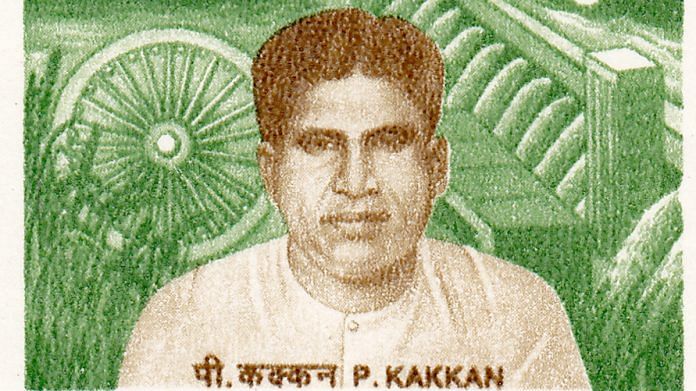
New Delhi: It is on a faded postage stamp, tucked away in the dusty pages of a notebook, that one might come across Tamil leader and Indian freedom fighter P. Kakkan’s passport-size photograph today.
The green-coloured stamp showing his oval-shaped face and its genial expression is telling of this man’s personality — ‘non-controversial’, ‘honest’ and ‘straightforward’. Having never chased fame, Kakkan is, however, one of those leaders who has been nearly forgotten in the annals of history.
Kakkan was a Dalit activist, a Congress leader and member of the Indian Constituent Assembly who held several important portfolios between 1957 and 1967.
But what Kakkan is most remembered for is the revolutionary event when he, along with fellow freedom fighter A. Vaidyanatha Iyer, president of the Harijan Sevak Sangh, and a few others led Dalits inside the Meenakshi-Sundareswarar temple in Madurai on 8 July, 1939 amid strong opposition from upper-caste Hindus.
Known for maintaining a simple lifestyle, Kakkan never used his political clout for personal gains — a stark reminder of how he never accumulated enough wealth and died a poor man.
Today, 18 June, marks his 111th birth anniversary.
Early life
Kakkan was born into a Dalit family at Thumbaipatti in Madurai district of Tamil Nadu. His father — Poosari Kakkan was a priest at a village shrine.
Kakkan completed his basic education from Perumalai High School, Thirumangalam. However, he failed in the SSLC (Secondary School Leaving Certificate) examination and left school.
He was married to Parvati with whom he had five sons and a daughter.
Also read: MS Golwalkar, the RSS chief who remains ‘Guruji’ to some, a ‘bigot’ to others
Life as an activist
Kakkan worked as a teacher for four years before getting involved in social work. He went on to steer several Dalit-led empowerment movements, including the famous Meenakshi temple event.
C. Rajagopalachari, the then chief minister of Madras Presidency, had called the incident a “miracle”. “I could not believe it. It seemed too good to be true…,” he had said.
Even Mahatma Gandhi had hailed Kakkan’s achievement in his paper Harijan.
“The opening of the state temples of Travancore was no doubt a great step but it was the prerogative of the Maharaja. But opening of the celebrated temple of Madurai is a greater event in that it is the popular will that has brought out this consummation,” Gandhi wrote.
The Hindu writes: “The entry into the Meenakshi Sundareswarar Temple assumes significance as the previous agitations demanding the right to enter Hindu temples and temple roads in Vaikkom, Guruvayur, Suchindrum of the erstwhile Travancore state and repeated attempts by Nadars in south Tamil Nadu were not so successful.”
Kakkan later went on to join the Congress and participated in the freedom struggle against British rule. He soon moved up the ladder to become secretary of the Taluka Congress Committee before being appointed as treasurer of the Madurai District Congress Committee.
Kakkan had met Gandhi during one of his visits to Madurai and also accompanied the latter in his travels. Impressed by Gandhi’s ideals, Kakkan took part in the Quit India movement. He was arrested by the British administration and jailed for one and a half years.
He became a member of the constituent assembly in 1946 during which time he also brought to light problems faced by those belonging to the scheduled castes. He fought for reservation in the police and military services.
Political career in independent India
Kakkan was elected to the first Lok Sabha from Madurai in 1951. From 1957 to 1967, he remained a member of the Madras Legislative Assembly.
In 1957, Kakkan became president of the Tamil Nadu Congress Committee. Many in the political circles today believe that he could have become Tamil Nadu’s first Dalit chief minister after Indian National Congress (INC) leader Kumaraswami Kamaraj’s resignation.
The Newsminute writes how it was “intra-party politics” that had ruined this prospect.
Kakkan became a minister in the Tamil Nadu government under Kamaraj (1954-63) and Minjur Bhaktavatsalam (1963-67).
During the 1962 Sino-Indian war, Kakkan made headlines in several national dailies for his charitable work. In an interview, his younger brother had said, “When Kamaraj was collecting funds for the 1962 Sino-India War, Kakkan took me to the podium and asked me to donate my gold chain.”
Also read: Bhajan Lal, the village sarpanch who rose to become Haryana’s powerful CM
Kakkan later went on to serve as the Minister of Public Works (1957-62), Minister of Agriculture (1962-63) and Minister for Home Affairs (1963-67) in the state government. He also played an important role in construction of dams, including the Vaigai Dam, and helped establish agriculture colleges across the state.
Kakkan contested the 1967 elections from Melur but was defeated by DMK’s O.P. Raman. Following this defeat, Kakkan retired from politics.
He died on 23 December, 1981 at the age of 73.

COMMENTS